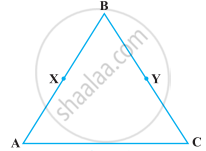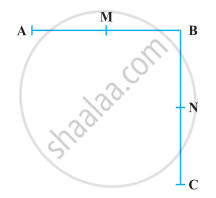Advertisements
Advertisements
प्रश्न
Solve the following question using appropriate Euclid’s axiom:
In the following figure, we have BX = `1/2` AB, BY = `1/2` BC and AB = BC. Show that BX = BY.

उत्तर
Given, BX = `1/2` AB
⇒ 2BX = AB ...(i)
BY = `1/2` BC
⇒ 2BY = BC ...(ii)
And AB = BC ...(iii)
On putting the values from equations (i) and (ii) in equation (iii), we get
2BX = 2BY
According to Euclid’s axiom, things which are double of the same things are equal to one another.
BX = BY
APPEARS IN
संबंधित प्रश्न
Give a definition of the following term. Are there other terms that need to be defined first? What are they, and how might you define them?
line segment
Consider two ‘postulates’ given below:-
- Given any two distinct points A and B, there exists a third point C which is in between A and B.
- There exist at least three points that are not on the same line.
Do these postulates contain any undefined terms? Are these postulates consistent? Do they follow from Euclid’s postulates? Explain.
Why is Axiom 5, in the list of Euclid’s axioms, considered a ‘universal truth’? (Note that the question is not about the fifth postulate.)
How many lines can be drawn through both of the given points?
How many planes can be made to pass through a line and a point not on the line?
“For every line l and for every point P not lying on a given line l, there exists a unique line m passing through P and parallel to l ” is known as Playfair’s axiom.
Solve the following question using appropriate Euclid’s axiom:
In the following figure, we have ∠1 = ∠2, ∠2 = ∠3. Show that ∠1 = ∠3.

In the following figure AB = BC, M is the mid-point of AB and N is the mid-point of BC. Show that AM = NC.

Read the following statements which are taken as axioms:
- If a transversal intersects two parallel lines, then corresponding angles are not necessarily equal.
- If a transversal intersect two parallel lines, then alternate interior angles are equal.
Is this system of axioms consistent? Justify your answer.
The following statement is true or false? Give reason for your answer.
There are an infinite number of lines which pass through two distinct points.
